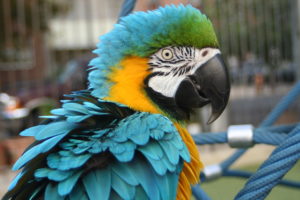By Tammy Attama, Virginia

A friend who knew I was fascinated with macaws surprised me with the birthday gift of a blue-and-gold macaw parrot named Harley. It was love at first sight for Harley and me.
I’ve had animals all my life and know when I’ve made a heart connection. There is an inward communication between the animal and me that is undeniable. I didn’t know at the time that this bird would change my life.
Macaws are intelligent and social birds. They live in flocks in Central and South American rain forests. Harley was an adolescent parrot when I adopted him—the age where some people, who haven’t had a macaw as a pet, lose patience and give up on them. Teenage parrots can be a handful and try a pet parent’s patience. They get very rambunctious and squawk loudly when ignored or are not getting their way. Sound is their way of communicating—calling and screeching.
Though I knew about birds’ reliance on sound, I hadn’t expected that Harley would become my teacher about the effects of sound, energy, and vibrations. Harold Klemp, spiritual teacher and author of The Spiritual Laws of Life, defines the spiritual Law of Vibrations as one that “governs all the influences such as wavelengths, outflows, inflows, cause and effect, and the harmonics of the movement of sound.” I had always viewed my high sensitivity to energies and vibrations as a flaw. Harley showed me that my awareness of them could actually be a gift.
Harley, My Mirror
After observing Harley for some time, I began to understand that he was making me more aware of my emotions. I learned that birds are quite sensitive to the energy of those around them. If I felt a bit irritated, Harley avoided me. He was sensing my feelings, sometimes even before I did, and reflecting them back.
If I insisted on handling him, despite his best efforts to discourage me, he would give a gentle bite at first. If I couldn’t take a hint, he bit a little more aggressively. I came to understand that he might not feel safe when he knew a person had become emotional.
Being a quick study, Harley knew instinctively who and when to trust. Whenever we went outdoors in nice weather, I could see him do what, in EMS (Emergency Medical Services), is called a scene-safety check. In mere seconds, he scoped the area to make sure all was well.
In the morning, while I prepared for the day, Harley and I danced to upbeat tunes of pop rock—any songs with a good beat. Harley danced on his perch, and I moved around the kitchen in time with the music as I fed and cared for him.
He screamed at heavy metal or music that was too loud. If he enjoyed an upbeat song, he bopped up and down and side to side. He liked the music of Britney Spears, “Party in the U.S.A.” by Miley Cyrus, Latin salsa, and the songs I played while practicing ballroom dancing.
Most of all, Harley loved to listen to the HU with me. This is a sacred, ancient chant that is taught in Eckankar. When I played a CD recording of a group of people singing the HU song, Harley seemed to enjoy this uplifting and peaceful sound.
Harley’s Lessons
I hold so much gratitude in my heart for this beautiful Soul. Harley showed me that we are energy beings and taught me to accept, as a gift, my ability to sense energies and vibrations. He showed me that although our eyes or ears may not perceive some things, that doesn’t mean they are not there.
Serving as a mirror for my moods and attitude, Harley taught me that when we project our emotions and thoughts onto others, we can affect them, even if we don’t realize it.
As our bond of love grew, I wondered, Would Harley start relating to my two children, two dogs, two cats, and me as his new flock?
(to be continued)
—Photo by Tammy Attama
Harley’s story is in three parts:
Part 1: “Harley, My Macaw Mirror” by Tammy Attama (posted August 21, 2018)
Part 2: “Harley and His Human Flock” by Tammy Attama (posted September 11, 2018)
Part 3: “Harley Finds a Macaw to Love” by Tammy Attama (to be posted)

Thank you for this wonderful story! I’ve noticed over the years with the animals I’ve rescued & the animals in my parent’s home, how much our dogs communicated their feelings daily. When my father was sick, our dogs never left his side, except to go outside or eat! My mother & I would HU to them also, so we all were growing more spiritual with each other too!
Hi Tammy
Thank you very much for shared the story from your heart here.
Very useful as well as I learned a lesson from lovely Soul Nearly – how my emotions/ feelings/vibrations affects in and around myself.
Once again say thanking you
Oh! Tammy,
Thank you for this great story. I sure am looking forward to parts 2 & 3!
And what a lovely site this is!
Love, Sue